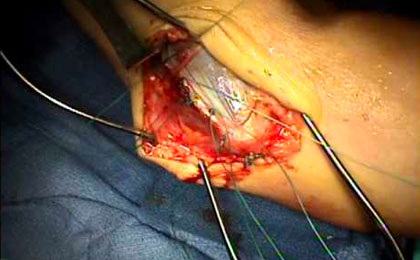Tommy John Surgery, referred to medically as an Ulnar Collateral Ligament (UCL) Reconstruction, became one of the more significant advances in sports medicine when it returned a renowned baseball pitcher of the LA Dodgers, Tommy John, to play after what had previously been a career ending injury.
One of the two stabilizing ligaments of the elbow, the UCL is located on the medial side (inner arm) of the elbow and can be damaged with repetitive stress or dislocation to the elbow. If not repaired properly, the elbow remains unstable. The Tommy John Surgery is designed to restore stability to the elbow and return athletes to their sport.
Before the procedure is performed a diagnostic arthroscopy may be indicated, in order to assess the extent of the damage or identify other conditions that may be contributing to the instability of the elbow joint.
The UCL Reconstruction entails an incision on the medial side of the elbow. The damaged UCL is then replaced with an autograft – a tendon taken from another part of the patient’s body (forearm, foot, hamstring, knee). Tissue taken from the patient’s own body adapts more readily. Revascularization is more rapid and outcome more successful with autografts.
Once the graft is harvested, it is anchored into place using one of several different techniques refined over the years. Tension is assessed and when determined optimal ligamentous tension to restore strength and stability to the elbow joint is achieved, final sutures are made.
The elbow is then placed in a bandage and splint. Postoperative rehabilitation is key in regaining full range of motion and begin within the first seven to 10 days following the procedure. An occupational therapist and rehabilitative specialists will work to establish a program to strengthen the entire arm and shoulder for a rapid return to play.


